Icebreakers are engaging activities designed to foster connections‚ ease social interactions‚ and create a welcoming environment for elementary students‚ helping them feel comfortable and encouraging active participation in the classroom․
What Are Ice Breakers?
Ice breakers are activities designed to help students feel comfortable and build connections in a classroom or group setting․ They are simple‚ engaging tasks that encourage interaction‚ reduce shyness‚ and create a positive environment․ Ice breakers can be movement-based‚ question-based‚ or group activities that foster teamwork and communication․ These tools are especially effective for elementary students‚ as they help establish a sense of belonging and make learning fun․ By breaking down initial hesitations‚ ice breakers set the stage for a collaborative and inclusive classroom culture‚ making it easier for students to participate and engage with their peers throughout the year․
Why Ice Breakers Are Important for Elementary Students
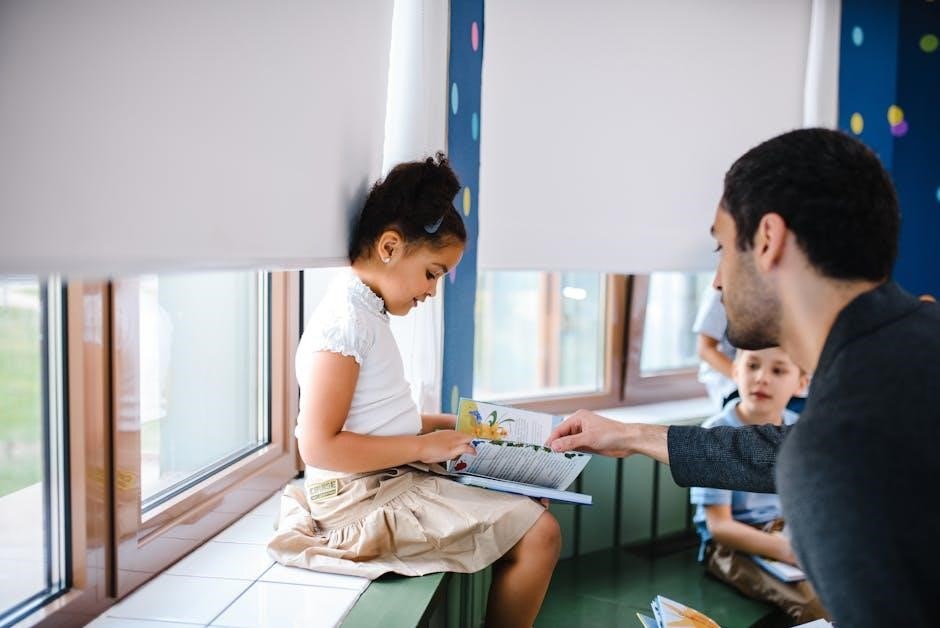
Ice breakers play a crucial role in elementary education by helping students overcome initial shyness and anxiety․ These activities foster a sense of belonging‚ encouraging students to interact with peers and teachers․ They build confidence‚ improve communication skills‚ and create a supportive classroom environment․ Ice breakers also help reduce first-day jitters‚ making the transition to a new academic setting smoother․ By promoting collaboration and inclusivity‚ they lay the foundation for a positive and engaged learning community․ Regular use of ice breakers can enhance social skills‚ encourage teamwork‚ and make the classroom a place where every student feels valued and comfortable expressing themselves․
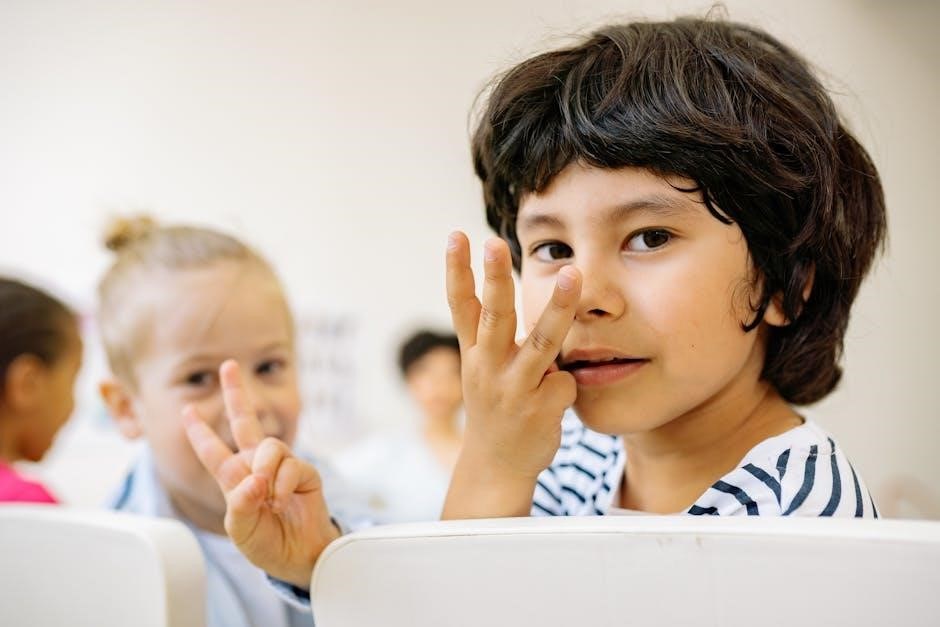
Types of Ice Breakers for Elementary Students
Ice breakers for elementary students include question-based‚ movement-based‚ and group-based activities․ These engaging strategies foster connections‚ encourage creativity‚ and promote teamwork‚ making learning fun and interactive for young minds․
Question-Based Ice Breakers
Question-based icebreakers are simple‚ effective tools for encouraging elementary students to share thoughts and feelings․ These activities use prompts like “What’s your favorite hobby?” or “If you could be any animal‚ why?” to spark conversations․ They help students feel comfortable expressing themselves‚ fostering a sense of community․ Teachers can adapt questions to suit different age groups‚ ensuring inclusivity․ Such activities not only break the ice but also provide insights into students’ personalities and interests‚ making them a valuable classroom tool for building connections and promoting engagement․ They are easy to implement and require minimal preparation‚ making them ideal for any classroom setting․
Movement-Based Ice Breakers
Movement-based icebreakers are interactive activities that combine physical movement with creativity‚ helping elementary students engage and connect․ These activities‚ such as creating unique gestures or sounds‚ encourage students to express themselves non-verbally while introducing themselves to the class․ For example‚ students might invent a movement or sound representing their name‚ then share it in a circle․ This approach fosters creativity‚ breaks down shyness‚ and allows students to learn about their peers in a fun‚ dynamic way․ Movement-based icebreakers are particularly effective for young learners‚ as they promote physical activity and provide an alternative to verbal introductions‚ making everyone feel included and energized․
Group-Based Ice Breakers
Group-based icebreakers are collaborative activities designed to encourage teamwork and interaction among elementary students․ These exercises often involve problem-solving or creative tasks that require students to work together․ For example‚ one popular activity involves dividing students into small groups and giving them a survival scenario‚ where they must combine imaginary items to increase their chances of success․ Another example is the “Human Bingo” game‚ where students mingle to find peers who fit specific traits or characteristics․ Group-based icebreakers foster teamwork‚ communication‚ and mutual understanding‚ helping students build relationships and feel more connected․ They also provide opportunities for shy students to participate in a supportive environment‚ making the classroom feel inclusive and engaging․
Benefits of Using Ice Breakers in the Classroom
Ice breakers foster connections‚ ease social interactions‚ reduce anxiety‚ encourage participation‚ and build a positive classroom environment‚ helping students feel comfortable and engaged from the start․
Building Classroom Community
Building a strong classroom community is essential for creating a supportive and inclusive learning environment․ Ice breakers play a crucial role in this process by helping students connect with one another and feel a sense of belonging․ When students participate in interactive activities‚ they learn to communicate effectively‚ respect each other’s perspectives‚ and collaborate as a team․ These early interactions lay the foundation for a positive classroom culture‚ where students feel safe to share ideas and take risks․ By fostering these relationships early on‚ teachers can create a cohesive group dynamic that promotes social and academic growth throughout the year․
Reducing First-Day Jitters
Ice breakers are invaluable for easing first-day jitters in elementary students․ These activities provide a fun and engaging way for students to introduce themselves‚ share simple facts about their interests‚ or participate in lighthearted games․ By focusing on shared experiences and playful interactions‚ ice breakers help students feel more at ease in a new environment․ This reduces anxiety and creates a welcoming atmosphere‚ allowing students to transition smoothly into the classroom setting․ Simple activities‚ such as name games or movement-based exercises‚ encourage students to connect with peers and teachers‚ fostering a sense of belonging from the very start of the school year․
Encouraging Student Participation
Ice breakers are an effective way to encourage student participation‚ especially for shy or hesitant learners․ By providing a safe and engaging environment‚ these activities help students feel comfortable contributing their thoughts and ideas․ Simple question-based games or movement-based exercises can lower anxiety and make participation feel natural․ Ice breakers also help students connect with peers‚ fostering a sense of belonging and collaboration․ This increased confidence often translates into more active involvement in classroom discussions and group work․ Additionally‚ ice breakers allow teachers to identify students’ interests‚ enabling them to tailor future activities to their needs‚ further promoting engagement and enthusiasm for learning․
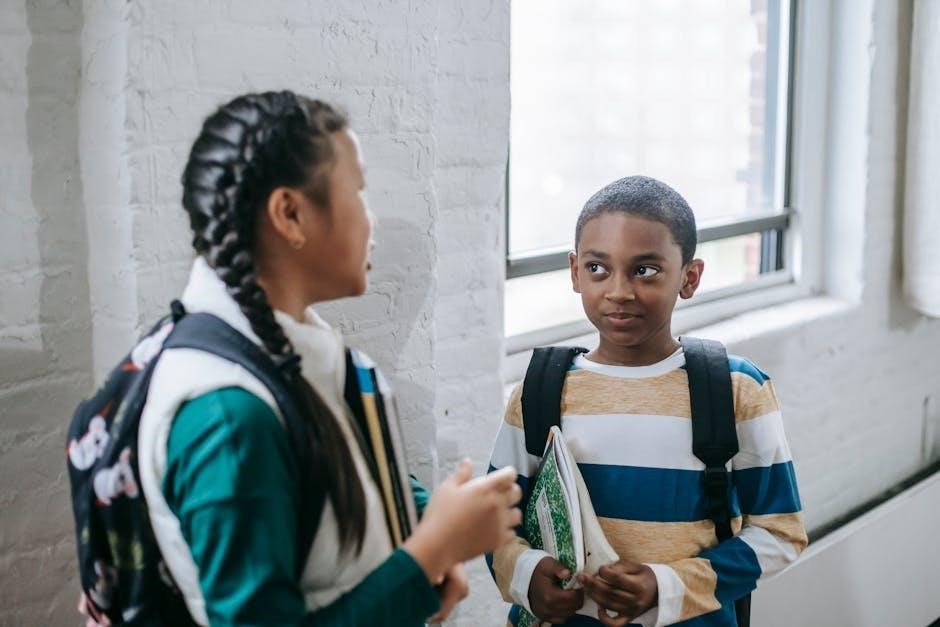
Popular Ice Breaker Activities for Elementary Students
Fun activities like The Name Game‚ Two Truths and a Lie‚ and The Human Bingo Game engage students‚ fostering connections and making learning enjoyable from the start․
The Name Game
The Name Game is a classic icebreaker activity that helps students learn and remember each other’s names in a fun and engaging way․ Students sit in a circle‚ and one by one‚ they introduce themselves by saying their name along with a unique movement‚ sound‚ or gesture․ For example‚ a student might say‚ “Hi‚ I’m Emma‚ and I love to dance!” while performing a simple dance move․ This activity is then repeated around the circle‚ allowing everyone to associate names with memorable actions or traits․ The Name Game fosters connections‚ eases first-day jitters‚ and creates a lively atmosphere‚ making it an excellent way to kick off the school year or any group setting․ It also encourages participation and helps build a sense of community among students․ By combining names with visual cues‚ the activity makes it easier for students to remember one another‚ promoting inclusivity and interaction․ This simple yet effective game is a great way to break the ice and set a positive tone for the classroom environment․
Two Truths and a Lie
Two Truths and a Lie is a fun and engaging icebreaker activity that encourages students to share interesting facts about themselves while sparking curiosity and laughter․ Each student presents two true statements and one false statement about themselves‚ such as hobbies‚ pets‚ or favorite foods․ The rest of the class then guesses which one is the lie․ This activity not only helps students get to know one another but also fosters critical thinking and listening skills․ It’s a simple yet effective way to create a relaxed atmosphere‚ allowing students to open up and connect with their peers․ The game also promotes teamwork and interaction‚ making it an ideal icebreaker for elementary students of all ages․ By sharing personal anecdotes‚ students build trust and camaraderie‚ laying the foundation for a positive classroom environment․ This activity is easy to implement and requires minimal preparation‚ making it a go-to choice for teachers looking to break the ice on the first day of school or in any group setting․ It’s a great way to help students feel comfortable and excited about getting to know each other․ The combination of truth and humor makes it a memorable experience for everyone involved․ Two Truths and a Lie is a timeless icebreaker that continues to be a favorite among both students and educators‚ offering a lighthearted way to build connections and encourage participation․ Its versatility allows it to be adapted to different age groups and classroom settings‚ ensuring its effectiveness in fostering a sense of community․ By encouraging students to share aspects of their lives‚ this activity helps create a supportive and inclusive environment where everyone feels valued․ It’s a powerful tool for helping students overcome shyness and feel more comfortable interacting with their classmates․ The activity also serves as a springboard for deeper conversations and friendships‚ making it an essential part of any classroom icebreaking strategy․ Two Truths and a Lie is more than just a game—it’s a way to build lasting connections and create a positive classroom culture․ Its simplicity and effectiveness make it a staple in many educators’ toolkits for fostering student engagement and collaboration․ By leveraging the power of storytelling and humor‚ this activity helps students break out of their shells and feel at ease with one another․ It’s a great way to kick off the school year or revitalize a classroom community at any time․ The activity’s success lies in its ability to balance fun with meaningful interaction‚ ensuring that students leave with new friendships and a sense of belonging․ Two Truths and a Lie is a proven method for breaking the ice and setting the stage for a successful and harmonious school year․ Its enduring popularity is a testament to its effectiveness in creating a welcoming and inclusive classroom environment․ By giving students the opportunity to share their unique experiences and interests‚ this activity helps build a foundation of mutual respect and understanding․ It’s a simple yet impactful way to encourage student participation and foster a sense of community․ Two Truths and a Lie is an excellent choice for teachers looking to create a positive and engaging classroom atmosphere․ Its versatility and ease of implementation make it a valuable resource for educators at all levels․ The activity’s focus on storytelling and interaction ensures that students are actively engaged and invested in getting to know their peers․ By incorporating Two Truths and a Lie into their icebreaking strategies‚ teachers can help students feel more connected and confident in their classroom environment․ This activity is a fun and effective way to break down barriers and build lasting relationships among students․ Its ability to combine humor with meaningful interaction makes it a standout choice for icebreakers in elementary classrooms․ Two Truths and a Lie is a timeless activity that continues to bring students together‚ fostering a sense of belonging and camaraderie․ Its simplicity and adaptability ensure its continued popularity among educators and students alike․ By encouraging students to share their stories and laugh together‚ this activity helps create a positive and supportive classroom culture․ It’s a powerful tool for breaking the ice and setting the tone for a successful school year․ Two Truths and a Lie is more than just a game—it’s a way to build connections‚ encourage participation‚ and create lasting memories․ Its impact on classroom dynamics is undeniable‚ making it a must-try activity for any educator looking to foster a welcoming and inclusive environment․ By leveraging the power of storytelling and humor‚ this activity helps students feel comfortable and confident in their ability to interact with their peers․ It’s a simple yet effective way to break the ice and set the stage for a positive and productive school year․ Two Truths and a Lie is a classic icebreaker that continues to be a favorite among students and teachers․ Its ability to combine fun with meaningful interaction makes it an essential tool for building classroom community․ By giving students the opportunity to share their unique experiences and interests‚ this activity helps foster a sense of mutual respect and understanding․ It’s a great way to encourage student participation and create a welcoming classroom environment․ Two Truths and a Lie is a proven method for breaking the ice and setting the tone for a successful school year․ Its versatility and ease of implementation make it a valuable resource for educators at all levels․ The activity’s focus on storytelling and interaction ensures that students are actively engaged and invested in getting to know their peers․ By incorporating Two Truths and a Lie into their icebreaking strategies‚ teachers can help students feel more connected and confident in their classroom environment․ This activity is a fun and effective way to break down barriers and build lasting relationships among students․ Its ability to combine humor with meaningful interaction makes it a standout choice for icebreakers in elementary classrooms․ Two Truths and a Lie is a timeless activity that continues to bring students together‚ fostering a sense of belonging and camaraderie․ Its simplicity and adaptability ensure its continued popularity among educators and students alike․ By encouraging students to share their stories and laugh together‚ this activity helps create a positive and supportive classroom culture․ It’s a powerful tool for breaking the ice and setting the tone for a successful school year․ Two Truths and a Lie is more than just a game—it’s a way to build connections‚ encourage participation‚ and create lasting memories․ Its impact on classroom dynamics is undeniable‚ making it a must-try activity for any educator looking to foster a welcoming and inclusive environment․ By leveraging the power of storytelling and humor‚ this activity helps students feel comfortable and confident in their ability to interact with their peers․ It’s a simple yet effective way to break the ice and set the stage for a positive and productive school year․ Two Truths and a Lie is a classic icebreaker that continues to be a favorite among students and teachers․ Its ability to combine fun with meaningful interaction makes it an essential tool for building classroom community․ By giving students the opportunity to share their unique experiences and interests‚ this activity helps foster a sense of mutual respect and understanding․ It’s a great way to encourage student participation and create a welcoming classroom environment․ Two Truths and a Lie is a proven method for breaking the ice and setting the tone for a successful school year․ Its versatility and ease of implementation make it a valuable resource for educators at all levels․ The activity’s focus on storytelling and interaction ensures that students are actively engaged and invested in getting to know their peers․ By incorporating Two Truths and a Lie into their icebreaking strategies‚ teachers can help students feel more connected and confident in their classroom environment․ This activity is a fun and effective way to break down barriers and build lasting relationships among students․ Its ability to combine humor with meaningful interaction makes it a standout choice for icebreakers in elementary classrooms․ Two Truths and a Lie is a timeless activity that continues to bring students together‚ fostering a sense of belonging and camaraderie․ Its simplicity and adaptability ensure its continued popularity among educators and students alike․ By encouraging students to share their stories and laugh together‚ this activity helps create a positive and supportive classroom culture․ It’s a powerful tool for breaking the ice and setting the tone for a successful school year․ Two Truths and a Lie is more than just a game—it’s a way to build connections‚ encourage participation‚ and create lasting memories․ Its impact on classroom dynamics is undeniable‚ making it a must-try activity for any educator looking to foster a welcoming and inclusive environment․ By leveraging the power of storytelling and humor‚ this activity helps students feel comfortable and confident in their ability to interact with their peers․ It’s a simple yet effective way to break the ice and set the stage for a positive and productive school year․ Two Truths and a Lie is a classic icebreaker that continues to be a favorite among students and teachers․ Its ability to combine fun with meaningful interaction makes it an essential tool for building classroom community․ By giving students the opportunity to share their unique experiences and interests‚ this activity helps foster a sense of mutual respect and understanding․ It’s a
The Human Bingo Game
The Human Bingo Game is a dynamic and interactive icebreaker that encourages students to move around‚ interact with peers‚ and find common interests․ Each student receives a bingo card with various traits‚ hobbies‚ or characteristics in each square‚ such as “has a pet dog” or “loves reading․” Students must find classmates who fit each description and collect signatures to complete their cards․ This activity fosters movement‚ teamwork‚ and conversation‚ helping students break out of their shells and build connections․ It’s an engaging way to reduce first-day jitters and create a lively classroom atmosphere while encouraging participation and collaboration․ The game also promotes inclusivity‚ allowing every student to contribute and feel valued‚ making it an excellent tool for building a strong classroom community․
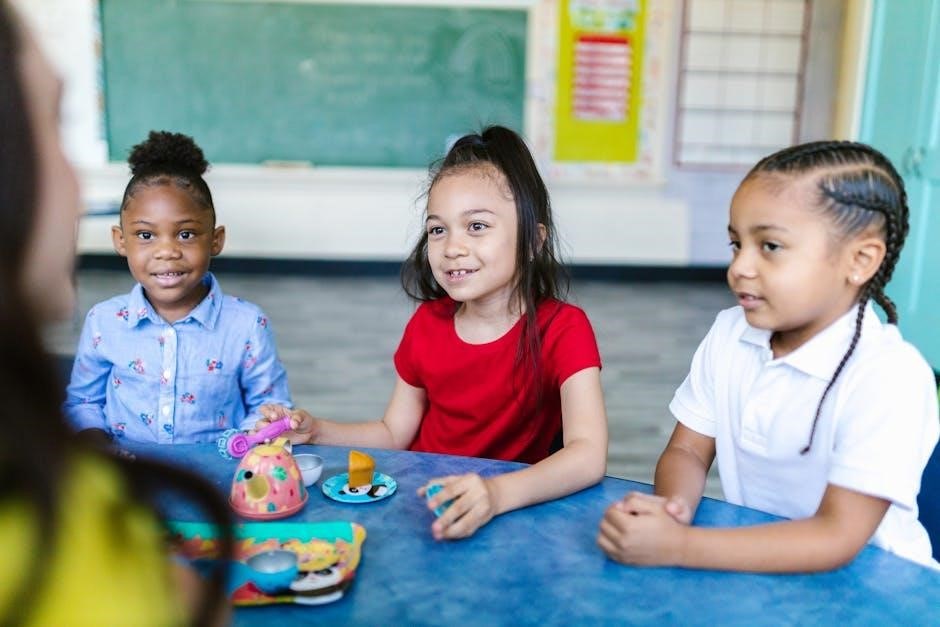
Ice Breakers for Virtual Learning Environments
Virtual icebreakers are essential for fostering connections in online classrooms․ Activities like online games‚ virtual name games‚ and interactive worksheets help students engage and build relationships remotely․ They make learning fun and inclusive‚ ensuring everyone feels connected despite physical distances․ These tools are designed to encourage participation‚ reduce anxiety‚ and create a sense of community in digital spaces․ By incorporating creative and interactive elements‚ virtual icebreakers help elementary students adapt to remote learning environments seamlessly․ They also provide opportunities for collaboration and socialization‚ making virtual classrooms dynamic and engaging for young learners․
Online Ice Breaker Games
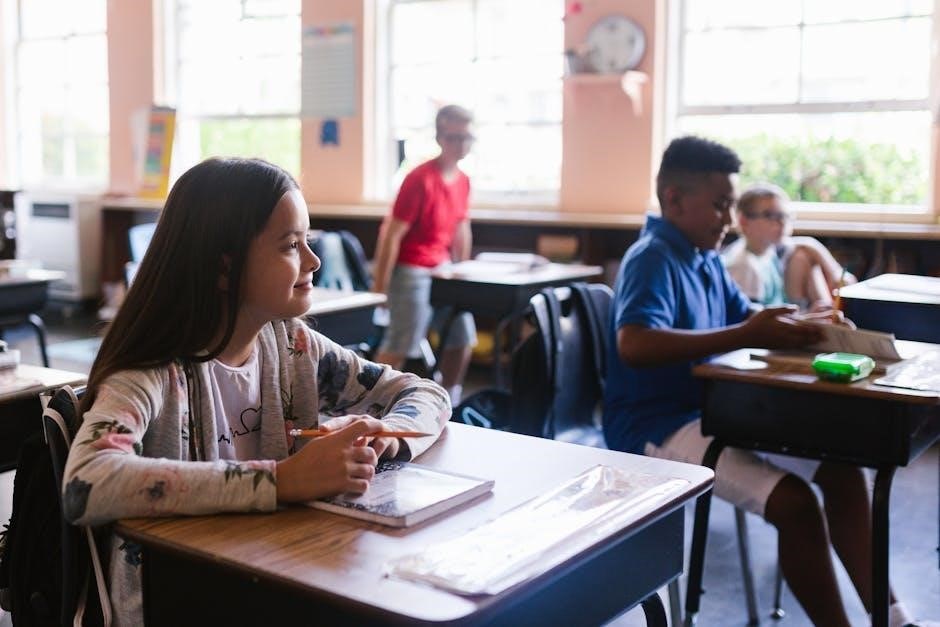
Online icebreaker games are a fantastic way to engage elementary students in virtual learning environments․ Games like “Two Truths and a Lie” and “The Name Game” can be adapted for online platforms‚ encouraging students to share fun facts about themselves․ Tools like Kahoot! or Google Jamboard allow for interactive quizzes and collaborative activities‚ making learning enjoyable․ These games help students connect‚ build friendships‚ and feel comfortable in a digital classroom․ They also promote teamwork and creativity‚ breaking down barriers and fostering a sense of community․ With minimal setup‚ online icebreakers ensure that virtual learning is both fun and inclusive‚ helping students adapt to remote environments seamlessly․
Virtual Name Games
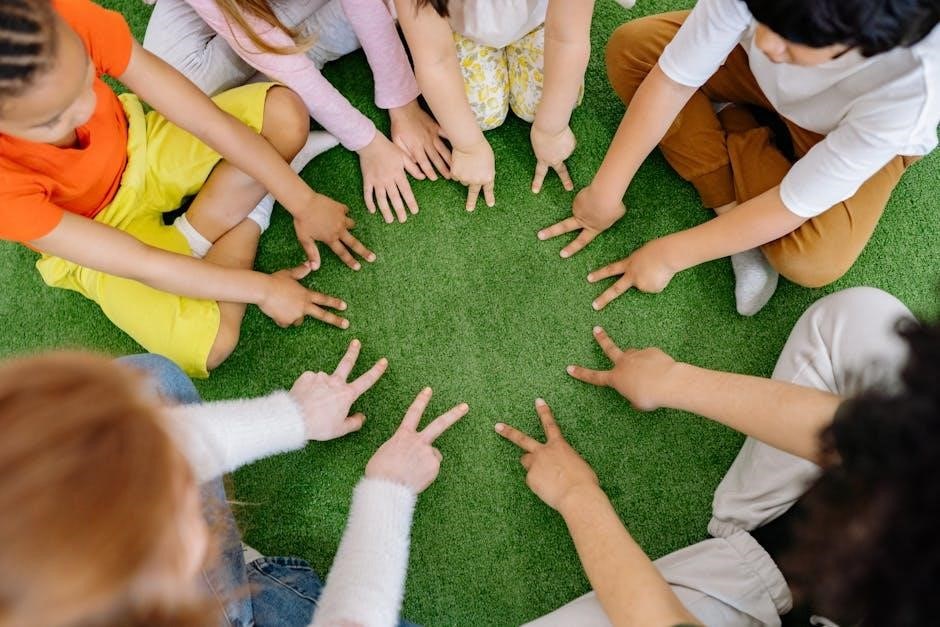
Virtual name games are an excellent way to help elementary students learn and remember each other’s names in online classrooms․ Activities like “Virtual Name Bingo” or “Guess the Name” encourage interaction and connection․ Teachers can create interactive slides where students share a fun fact along with their name‚ making it easier for peers to associate names with faces․ Tools like Kahoot! or Google Jamboard can be used to create engaging name-based quizzes․ These games not only simplify name learning but also foster a sense of belonging and collaboration․ By incorporating movement or sound‚ virtual name games can keep young students engaged and excited about participating in remote learning environments․
Interactive Ice Breaker Worksheets
Interactive ice breaker worksheets are a fantastic way to engage elementary students in fun‚ structured activities that encourage sharing and connection․ These worksheets often include prompts like ” Draw a picture of your favorite hobby” or “Write three things about yourself that start with the same letter as your name․” Teachers can find free‚ downloadable templates on platforms like Teachers Pay Teachers‚ tailored for virtual or in-person learning․ Students enjoy the hands-on aspect‚ while teachers appreciate how these sheets help students open up and bond․ Many worksheets also incorporate movement or sound‚ making them versatile tools for fostering classroom community and reducing first-day jitters in a creative‚ child-friendly way․
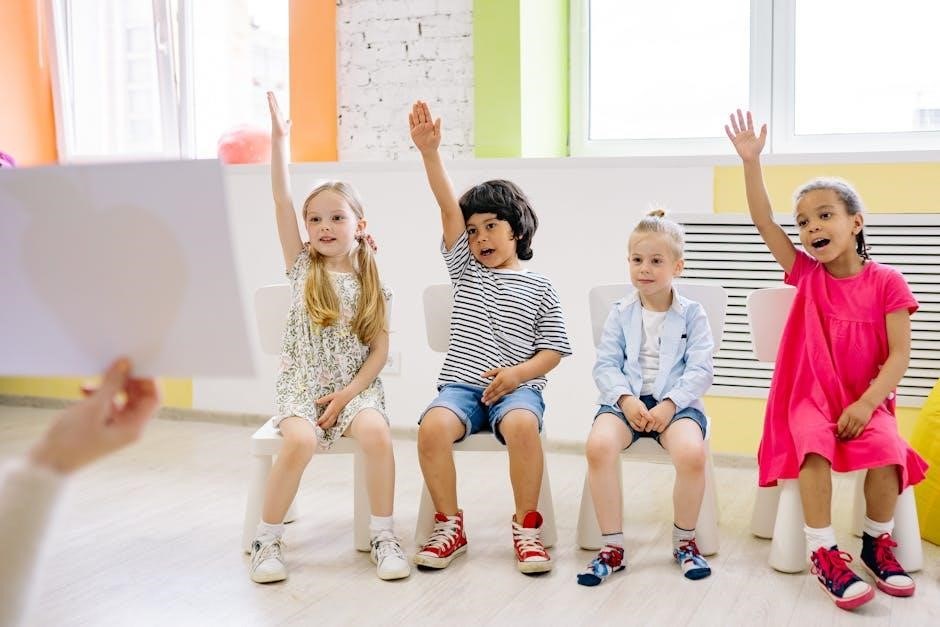
Ice Breakers for Diverse Classroom Settings
Diverse classrooms require icebreakers tailored to ensure inclusivity and cultural sensitivity‚ helping students feel valued and connected while fostering a positive learning environment․
Culturally Responsive Ice Breakers
Culturally responsive icebreakers celebrate students’ diverse backgrounds‚ fostering inclusivity and empathy․ These activities encourage sharing traditions‚ languages‚ or cultural practices‚ helping students feel respected and valued․ For example‚ asking students to share a cultural tradition or teaching a simple phrase in another language can bridge gaps․ These icebreakers not only build connections but also promote cross-cultural understanding‚ creating a safe space for all voices to be heard․ By incorporating cultural elements‚ educators ensure that every student feels a sense of belonging‚ which is crucial for a positive and inclusive classroom environment․
Inclusive Ice Breaker Activities
Inclusive icebreakers ensure every student feels valued and engaged‚ regardless of their abilities or backgrounds․ Activities like “All About Me” posters or sharing personal interests in small groups allow students to express themselves comfortably․ Non-verbal games‚ such as charades or gesture challenges‚ cater to those who may feel anxious about speaking․ Collaborative puzzles or group art projects encourage teamwork and interaction․ These activities promote empathy and a sense of belonging while accommodating diverse learning styles and abilities․ By focusing on shared experiences‚ inclusive icebreakers help create a supportive classroom environment where all students can thrive and connect with one another․
Ice Breakers for Students with Disabilities
Icebreakers for students with disabilities are designed to ensure inclusivity and accessibility‚ fostering participation and connection․ Activities like “Two Truths and a Lie” or movement-based games can be adapted to accommodate different abilities․ Visual aids‚ such as pictures or gestures‚ help students who may struggle with verbal communication․ Tactile activities‚ like collaborative puzzles‚ engage those with sensory needs․ These icebreakers promote a supportive environment‚ allowing all students to feel included and valued․ By tailoring activities to individual needs‚ educators create opportunities for meaningful interaction and build a classroom community that celebrates diversity and fosters understanding among all learners․
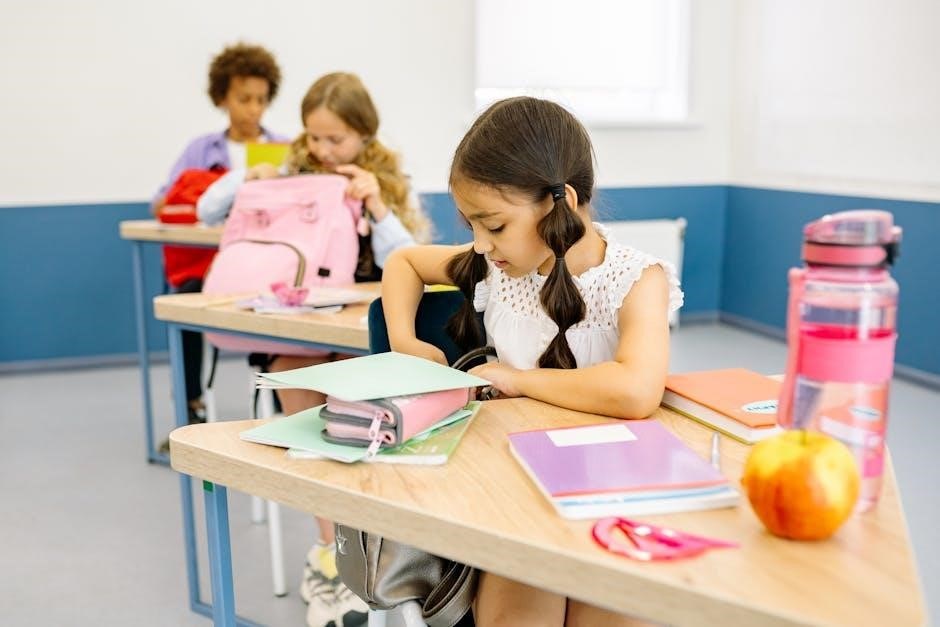
How to Implement Ice Breakers Effectively
Choose activities that align with your class’s needs‚ keep timing short and fun‚ and always debrief to connect the icebreaker to classroom goals and values․
Choosing the Right Ice Breaker for Your Class
Selecting the perfect icebreaker involves considering your class size‚ age group‚ and diversity․ Opt for activities that align with your students’ energy levels and interests․ For younger grades‚ movement-based games like “Freeze Dance” or “Animal Moves” engage students and encourage physical interaction․ For older elementary students‚ question-based icebreakers such as “Two Truths and a Lie” or “Would You Rather” foster critical thinking and conversation․ Ensure the activity promotes inclusivity and respects cultural differences․ Timing is crucial—keep it short and fun to maintain focus․ Always debrief afterward to connect the activity to classroom goals‚ reinforcing teamwork and communication skills․ This thoughtful approach ensures a positive and meaningful experience for all students․
Timing and Duration of Ice Breakers
Timing and duration are critical when implementing icebreakers in the classroom․ Icebreakers should be brief‚ lasting between 5 to 15 minutes‚ to maintain students’ attention and engagement․ For younger elementary students‚ shorter activities (5-7 minutes) are ideal‚ while older students can handle slightly longer sessions (10-15 minutes)․ Consider the complexity of the activity and the class size when deciding duration․ Icebreakers work best at the beginning of a lesson or class to set a positive tone․ Mid-class icebreakers can refocus students‚ while end-of-class activities can reinforce learning․ Ensure the timing aligns with the activity’s purpose and the students’ energy levels․ Ending with a brief reflection can enhance the experience and reinforce its benefits․
Debriefing After Ice Breaker Activities
Debriefing after icebreaker activities is essential to help students reflect on their experiences and solidify new connections․ This step encourages students to share insights‚ discuss what they learned‚ and connect the activity to broader classroom goals․ Teachers can guide the discussion with open-ended questions‚ such as‚ “What did you learn about your classmates?” or “How did this activity make you feel?” Debriefing also allows students to process any challenges they faced and celebrate successes․ By taking a few minutes to reflect‚ students gain a deeper understanding of the activity’s purpose and develop a stronger sense of community․ This practice fosters meaningful conversations and reinforces the value of teamwork and collaboration․
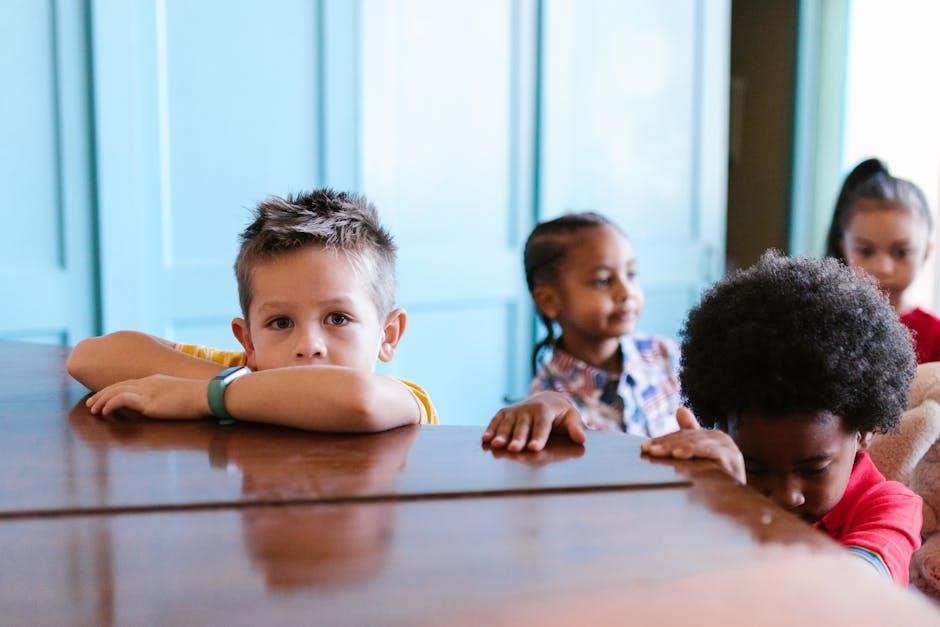
Resources for Elementary Teachers
Discover free icebreaker worksheets‚ interactive games‚ and online communities like Teachers Pay Teachers to find engaging activities and share ideas for elementary classrooms․
Free Ice Breaker Worksheets
Free icebreaker worksheets are a valuable resource for elementary teachers‚ offering engaging activities to help students connect and build classroom community․ These worksheets often include fun prompts‚ games‚ and exercises designed to encourage participation and teamwork․ Many websites‚ such as Teachers Pay Teachers‚ provide downloadable and printable worksheets tailored for young learners․ Activities like name games‚ “Two Truths and a Lie‚” and human bingo are popular choices․ These worksheets are easy to adapt for both in-person and virtual learning environments‚ making them versatile tools for diverse classroom settings․ They also cater to students with disabilities‚ ensuring inclusivity and accessibility․ By using these resources‚ teachers can create a welcoming atmosphere and foster ongoing student interaction throughout the school year․
Ice Breaker Games for Elementary Students
Icebreaker games are interactive activities designed to help elementary students build connections and feel comfortable in the classroom․ Games like “Two Truths and a Lie” and “The Name Game” encourage students to share fun facts about themselves while fostering teamwork and creativity․ “Human Bingo” is another popular activity where students mingle to find peers who fit specific traits‚ promoting social interaction․ These games are easy to implement‚ require minimal preparation‚ and can be adapted for both in-person and virtual learning environments․ They help reduce first-day jitters‚ encourage participation‚ and create a positive classroom atmosphere․ By incorporating these engaging games‚ teachers can set the stage for a collaborative and inclusive learning environment throughout the year․
Online Communities for Sharing Ice Breaker Ideas
Online communities are invaluable resources for teachers seeking innovative icebreaker ideas for elementary students․ Platforms like Teachers Pay Teachers and educational forums offer a wealth of downloadable activities‚ worksheets‚ and games․ Social media groups and blogs dedicated to elementary education often share creative icebreakers tailored for young learners․ These communities allow educators to exchange ideas‚ discover new strategies‚ and adapt activities to suit their classroom needs․ Many resources are free or low-cost‚ making it easy for teachers to find engaging and effective icebreakers․ By participating in these online spaces‚ educators can foster connections among students while building a supportive and interactive learning environment․
Icebreakers are essential for creating a positive classroom atmosphere‚ fostering connections‚ and encouraging student interaction․ They help elementary students feel comfortable‚ promoting a supportive and inclusive learning environment․
Encouraging Ongoing Student Interaction
The Importance of Consistent Ice Breaker Use
Consistent use of icebreakers fosters a sense of community and belonging‚ helping elementary students feel secure and valued․ Regular activities ensure ongoing interaction‚ encouraging friendships and collaboration while reducing shyness and anxiety․ By making icebreakers a routine part of classroom life‚ educators create a predictable and supportive environment where students can confidently express themselves․ This consistency also helps build trust among peers and between students and teachers‚ laying a strong foundation for academic success and social growth throughout the school year․ It’s a simple yet powerful strategy to promote engagement and unity in diverse classroom settings․

